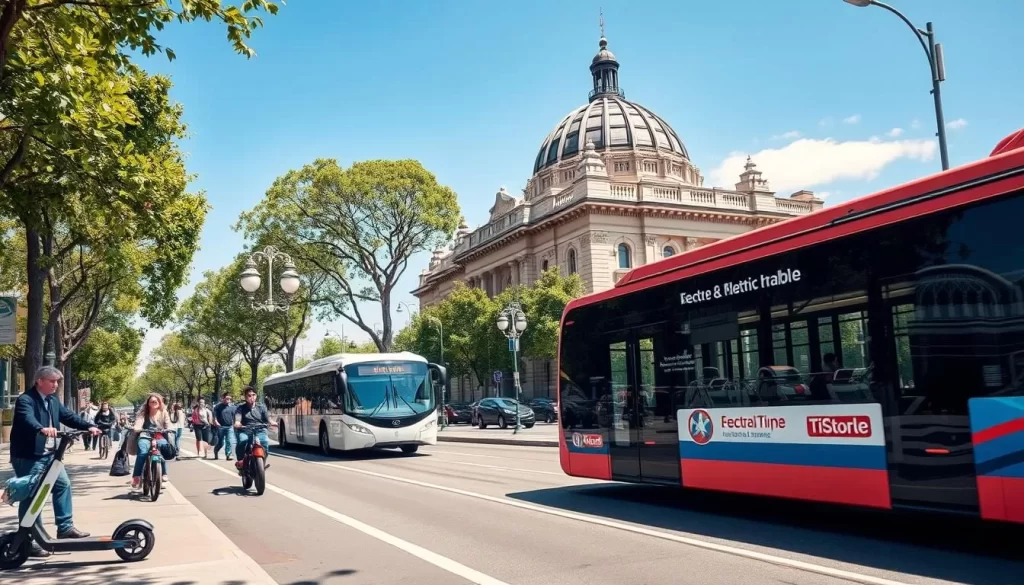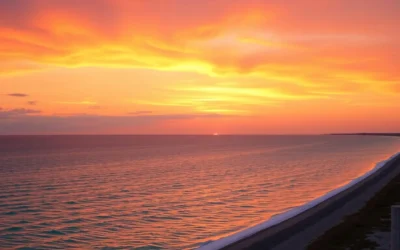✓ Accommodations✓ Flights✓ Rental Cars✓ Tours & Activities ✓ Tours & Activities
Choosing the right time for your journey can make all the difference. Understanding the season and its weather patterns ensures you’re prepared for what’s ahead. Whether you’re packing for warmth or planning outdoor activities, knowing the best time to visit can enhance your experience.
Each month brings unique weather features, from chilly winters to sunny summers. For example, summer temperatures can reach up to 80°F, perfect for outdoor festivals and exploring. Meanwhile, winter lows can drop to 23°F, ideal for ice skating and snow activities.
This guide will help you navigate the seasonal trends, so you can plan your trip with confidence. From packing tips to event highlights, you’ll find everything you need to make the most of your visit. Let’s dive into the details and get you ready for an unforgettable adventure.
Overview of Ontario’s Seasons
Exploring the weather patterns can transform your travel experience. This region is known for its four season climate, each offering unique conditions and opportunities. Whether you’re chasing summer warmth or winter snow, understanding these patterns ensures you’re always prepared.
Understanding Ontario’s Four Distinct Seasons
Ontario’s climate is defined by four distinct seasons: spring, summer, fall, and winter. Each brings its own charm and challenges. Summers are warm, with average temperatures ranging from 68°F to 82°F, perfect for outdoor festivals and water activities. Winters, on the other hand, often see temperatures drop below freezing, creating ideal conditions for ice skating and snow sports.
Temperature Trends and Precipitation Patterns
Temperature trends vary significantly throughout the year. In summer, highs can reach up to 81°F, while winter lows can dip to 21°F. Rainfall is most common in summer, with July and August being the wettest months. Winter brings frequent snowfall, making it a haven for winter sports enthusiasts.
Fall is particularly enchanting, with temperatures ranging from the 70s in September to the 40s in November. This season is known for its vibrant foliage and moderate conditions, making it a favorite for hiking and outdoor exploration. Understanding these trends helps you plan activities that align with the weather.
Ontario, Canada: Best Months for a Weather-Savvy Trip
Timing your visit perfectly can elevate your travel experience. Knowing the best time visit ensures you enjoy comfortable weather and fewer crowds. Whether you’re a first-time visitor or a local, understanding seasonal trends helps you plan better.
Summer, from June to August, is ideal for sunny days and outdoor activities. Temperatures often peak around 81°F, making it perfect for exploring the city or nearby attractions. However, this is also the busiest period, so booking early is essential.
Fall, particularly September and October, offers a quieter experience. The weather is mild, and the scenery is stunning with colorful foliage. October is especially great for national parks, with fewer crowds and lower accommodation rates.
Winter and spring have their own charm. Winter brings snowy landscapes and festive events, while spring sees nature come alive. Each season offers unique opportunities, so your choice depends on your preferences.
Planning your time visit around local events and weather ensures a memorable trip. Stay tuned for a detailed breakdown of each season to help you decide the perfect place and time for your adventure.
Seasonal Weather Breakdown: Spring, Summer, Fall, and Winter
Understanding the seasonal weather patterns can help you plan your trip more effectively. Each season offers unique conditions and opportunities for outdoor activities. From the warmth of summer to the crisp air of fall, there’s something for everyone.
Spring: Budding Activity and Unpredictable Swings
Spring brings new growth and unpredictable weather. Temperatures range from 32°F in March to 57°F in May, making it a transitional period. Rainfall is common, with April averaging 2.4 inches of precipitation.
This season is perfect for exploring parks and gardens as nature comes alive. However, be prepared for sudden weather changes. Layered clothing is your best friend during this time.
Summer: Hot, Humid Days and Outdoor Festivals
Summer is the peak season for outdoor activities. July is the hottest month, with average highs of 81°F. It’s also the best time for swimming, with sea temperatures reaching 70.5°F.
Outdoor festivals and events are in full swing during this time. From music to food, there’s always something happening. Just remember to stay hydrated and wear sunscreen.
Fall: Crisp Air and Colorful Foliage
Fall is a favorite for many, with its crisp air and vibrant foliage. Temperatures drop from 62°F in September to 39°F in November. This season is ideal for hiking and exploring national parks.
Cultural events like the Toronto International Film Festival (TIFF) attract visitors from around the world. It’s a quieter time to visit, with fewer crowds and stunning scenery.
Winter: Cold Snaps and Seasonal Sports
Winter brings cold temperatures and plenty of snow. January is the coldest month, with lows averaging 16°F. Snowfall is common, making it perfect for winter sports like skiing and ice skating.
Festive events like the Toronto Christmas Market add to the seasonal charm. Just bundle up and enjoy the winter wonderland.
| Season | Average Temperature | Key Activities |
|---|---|---|
| Spring | 32°F – 57°F | Park exploration, gardening |
| Summer | 66°F – 81°F | Festivals, swimming |
| Fall | 39°F – 62°F | Hiking, cultural events |
| Winter | 16°F – 30°F | Winter sports, holiday markets |
Planning Your Trip Around Ontario’s Peak and Off-Peak Seasons
Traveling during the right season can make your experience unforgettable. Whether you’re drawn to bustling festivals or serene landscapes, understanding peak and off-peak periods helps you plan better. Let’s explore what to expect during these times and how to make the most of your journey.
What to Expect During Busy Summer Months
Summer is the peak travel season, with warm weather and numerous events attracting large crowds. From outdoor concerts to cultural festivals, there’s always something happening. However, popular spots can get crowded, and accommodations may book up quickly.
To navigate this busy period, book your stay and tickets well in advance. Arrive early at attractions to avoid long lines. Pack light but include essentials like sunscreen and water to stay comfortable during long days of exploration.

Advantages of Off-Peak and Winter Visits
Off-peak travel, especially in winter, offers a quieter and more relaxed experience. You’ll encounter fewer crowds and often find better deals on accommodations and flights. Winter also brings unique events like ice festivals and holiday markets, adding charm to your trip.
Winter sports enthusiasts will love the snowy landscapes, perfect for skiing and ice skating. If you’re planning a winter visit, dress in layers to stay warm and check local weather forecasts for any sudden changes.
By choosing off-peak times, you can enjoy a more intimate experience with fewer distractions. Whether it’s a peaceful hike or a cozy evening by the fire, these moments make for lasting memories.
How to Dress and Pack for Every Season in Ontario
Packing smartly for your trip ensures you’re ready for any weather surprises. Ontario’s climate can be unpredictable, so versatility is key. Layering is the best way to stay comfortable, whether you’re exploring the city or hiking in the wilderness.
Layering Essentials for Unpredictable Weather
Layering allows you to adapt to sudden temperature changes. Start with a moisture-wicking base layer to keep sweat away from your skin. Add a warm mid-layer like a fleece or sweater, and finish with a waterproof outer layer to shield against rain or wind.
This approach works well in spring and fall when temperatures can swing dramatically. For example, April’s average low is 39°F, but it can rise to 57°F by the end of the month. Packing layers ensures you’re prepared for these shifts.
Rain Gear and Seasonal Clothing
Rain is common in certain months, so waterproof gear is a must. An umbrella, rain jacket, and waterproof shoes will keep you dry during unexpected showers. In April, there’s a 36.7% chance of experiencing rain during your visit.
For summer, lightweight and breathable fabrics are ideal. Winter demands thermal layers, insulated jackets, and accessories like gloves and hats. Dressing appropriately for the season ensures you enjoy your activities without discomfort.
Packing Tips for Different Activities
Urban sightseeing requires comfortable shoes and a lightweight backpack. For outdoor adventures, pack sturdy boots, a hat, and sunscreen. Smart packing is the best deal to avoid overloading your luggage while staying prepared for any scenario.
| Season | Essential Items |
|---|---|
| Spring | Light jacket, waterproof shoes, umbrella |
| Summer | Breathable clothes, sunscreen, hat |
| Fall | Layers, rain jacket, hiking boots |
| Winter | Thermal layers, insulated jacket, gloves |
By following these tips, you’ll be ready for any weather during your visit. Smart packing ensures you stay comfortable and make the most of your trip, no matter the season.
Top Seasonal Activities and Events in Ontario
Discover the vibrant seasonal activities and events that make every visit unforgettable. Whether you’re a fan of outdoor festivals, cultural gatherings, or winter sports, there’s something for everyone. The local climate plays a key role in shaping these experiences, ensuring each day is packed with excitement.

Outdoor Festivals, Sports, and Cultural Events
Summer is the perfect great time to enjoy outdoor festivals and sports. The Toronto International Film Festival (TIFF) attracts over 480,000 attendees annually, showcasing more than 375 films from 80 countries. It’s a cultural highlight that draws film enthusiasts from around the globe.
For music lovers, the Summer Music in the Garden series offers 18 free concerts, creating a lively atmosphere. Sports fans can also enjoy the Canadian National Exhibition, one of the largest annual fairs in North America, running from mid-August through Labor Day weekend.
Holiday Celebrations and Winter Sports
Winter transforms the region into a festive wonderland. Events like the Toronto Christmas Market and Nuit Blanche, a 12-hour art festival, add to the seasonal charm. These celebrations are perfect for creating lasting memories.
Winter sports enthusiasts will love the snowy landscapes, ideal for skiing and ice skating. The climate ensures plenty of snow, making it a haven for outdoor activity. Whether you’re carving down slopes or gliding across frozen lakes, it’s a great time to embrace the season.
Plan your visit to balance indoor and outdoor options, ensuring you make the most of every day. For more tips on the best times to explore, check out this guide.
Budget Travel Tips for Different Months
Traveling on a budget doesn’t mean sacrificing comfort or missing out on great experiences. With the right strategies, you can save money while still enjoying your trip. Whether you’re planning for the peak season or exploring during quieter months, these tips will help you keep your expenses light.
Finding Deals on Accommodations and Flights
One of the best ways to save is by adjusting your travel dates. Flights on Tuesdays can be up to 15% cheaper than weekend trips. For accommodations, consider booking during the shoulder season when prices drop by 20-50% compared to the peak season.
Another thing to keep in mind is flexibility. If you’re open to midweek travel or staying in budget-friendly options like hostels, you can significantly reduce costs. For example, dormitory-style accommodations can save you 50-70% compared to hotels.
Booking in advance is another smart move. Early reservations can save you 10-30% on flights and ensure you secure the best rates. This approach is especially helpful for every person looking to travel on a budget.
Practical Strategies for Every Traveler
Keeping your travel light financially allows you to enjoy more activities during your visit. For instance, cooking meals instead of dining out can save you around 50% on food expenses. Public transport is another cost-effective option, reducing travel costs by 40-60% compared to flying.
If you’re traveling during the peak season, consider exploring lesser-known destinations. These spots often have lower prices and fewer crowds, making them a great alternative. For more tips on traveling affordably, check out this guide.
By following these strategies, you can make the most of your trip without breaking the bank. Whether it’s adjusting your dates or choosing budget-friendly options, these tips ensure a memorable experience for every person.
Local Insights: Weather Trends in Ontario Cities
Weather patterns vary significantly across different cities. Understanding these trends helps you choose the best place visit and plan activities accordingly. From bustling urban centers to serene parks, each part of the region offers unique experiences shaped by its climate.
Comparing Toronto, Ottawa, and Other Regions
Toronto and Ottawa have distinct weather patterns. In Toronto, winter temperatures seldom dip below 20°F, while summer highs can reach around 80°F. Ottawa, on the other hand, experiences colder winters, with temperatures averaging in the low 10°F range.
Spring in Toronto spans from March to May, with temperatures ranging from 27°F in March to 66°F in May. This season is perfect for exploring parks like High Park, known for its cherry blossoms. Ottawa’s spring is similar but slightly cooler, making it a quieter place visit with fewer crowd conditions.

Understanding Humidity, Temperature, and Snow Patterns
Humidity and snowfall also vary by region. Toronto’s summer humidity can make warm days feel hotter, while Ottawa’s drier air provides a more comfortable experience. Snowfall is heavier in Ottawa, averaging 50 inches annually, compared to Toronto’s milder winters.
For those seeking outdoor activities, parks like Tommy Thompson Park in Toronto are ideal for bird watching in spring. In Ottawa, the Rideau Canal offers a unique winter experience with its frozen pathways. Choosing the right part of the region ensures you enjoy the best weather and fewer crowd conditions.
Tailor your itinerary based on these insights. Whether you’re exploring urban attractions or serene parks, understanding local weather trends ensures a memorable trip.
Planning Your Itinerary: Balancing Weather and Activities
Crafting the perfect itinerary requires balancing weather and activities. By aligning your plans with the forecast, you can maximize your experience and avoid unexpected surprises. Whether you’re planning a ski trip or dining at a local restaurant, understanding the weather ensures you’re prepared for every moment.
Flexible Travel Dates for Optimal Deals
Setting flexible travel dates can save you money and enhance your trip. High-season travel often means higher prices, while low-season trips may offer better deals but less favorable weather. The shoulder season is ideal, combining reasonable prices with good weather and fewer crowds.
For example, planning a ski trip during the shoulder season can save you up to 20% on accommodations. Similarly, dining at a local restaurant during off-peak hours can reduce wait times and costs. Flexibility allows you to enjoy more activities without stretching your budget.
Weather Considerations for Activities
Weather plays a key role in shaping your itinerary. If you’re planning outdoor activities like skiing or ice skating, check the forecast for snow and ice conditions. For indoor experiences, such as visiting museums or dining at a restaurant, weather is less of a concern.
Seasonal changes also impact prices. Winter activities like skiing often cost more during peak months, while summer attractions may have higher demand. By adjusting your plans, you can enjoy your favorite activities at a lower price.
Practical Tips for Balancing Your Itinerary
Here are some tips to help you balance weather and activities:
- Monitor price fluctuations for flights and accommodations.
- Plan outdoor activities around the forecast to avoid bad weather.
- Mix indoor and outdoor experiences to stay flexible.
- Use apps to track weather changes and adjust your plans accordingly.
For more insights on adapting your itinerary to seasonal changes, check out this guide.
| Activity | Best Season | Price Range |
|---|---|---|
| Skiing | Winter | $$$ |
| Dining at a Restaurant | Shoulder Season | $$ |
| Ice Skating | Winter | $$ |
Weather-Smart Transportation and Accommodation Strategies
Smart planning for transportation and lodging can make your trip smoother and more enjoyable. Whether you’re a seasoned traveler or a first-time tourist, understanding seasonal fluctuations helps you secure the best deals and avoid surprises. Let’s explore how to navigate these challenges effectively.

Booking Tips for Every Season
Planning ahead gives you a significant advantage, especially during peak travel periods. For example, booking flights and accommodations during shoulder seasons can save you up to 30% compared to peak times. This approach also ensures better availability and more options.
During the peak tourist season, prices for hotels and flights tend to rise. To avoid this, consider booking at least three months in advance. This strategy not only secures better rates but also gives you more flexibility in choosing your preferred locations.
Adjusting Plans for Unexpected Weather
Weather can be unpredictable, so it’s essential to have a backup plan. For instance, if you’re traveling during hurricane season, ensure your accommodation has flexible cancellation policies. This way, you can adjust your plans without losing money.
Public transportation is another area where weather can impact your trip. In colder months, delays are more common due to snow or ice. Always check local forecasts and have alternative routes in mind to stay on schedule.
Choosing the Right Accommodation
Selecting accommodations that cater to both comfort and cost is crucial. During heavy tourist seasons, consider staying in less crowded areas. These locations often offer better rates and a more relaxed atmosphere.
For first-time tourist travelers, choosing accommodations with amenities like free Wi-Fi and breakfast can enhance the experience. These small perks can make a big difference, especially when traveling on a budget.
| Season | Booking Strategy | Key Considerations |
|---|---|---|
| Peak Season | Book 3+ months in advance | Higher prices, limited availability |
| Shoulder Season | Flexible dates, last-minute deals | Lower prices, fewer crowds |
| Low Season | Monitor weather forecasts | Budget-friendly, weather risks |
By following these strategies, you can make the most of your trip, regardless of the season.
Conclusion
Planning your journey around seasonal weather patterns ensures you make the most of your visit. Every year brings unique opportunities to explore, whether you’re enjoying sunny days or embracing the charm of the coldest month. With the right preparation, you can turn any season into an unforgettable adventure.
From cozy stays in a well-chosen hotel to outdoor activities tailored to the weather, there’s something for everyone. Use this guide as a practical resource to navigate the changing seasons and discover the best experiences. A well-planned trip ensures lasting memories and a truly rewarding experience.
Ready to start your adventure? Check out this for more insights into making the most of your travels. Whether it’s your first visit or a return trip, there’s always something new to discover.
The above is subject to change.
Check back often to TRAVEL.COM for the latest travel tips and deals.






